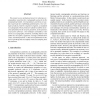143 search results - page 3 / 29 » A Range Test Secure in the Active Adversary Model |
ASIACRYPT
2008
Springer
15 years 1 months ago
2008
Springer
Abstract. In secure computation among a set P of players one considers an adversary who can corrupt certain players. The three usually considered types of corruption are active, pa...
ASIACRYPT
2000
Springer
15 years 3 months ago
2000
Springer
A conference key protocol allows a group of participants to establish a secret communication (conference) key so that all their communications thereafter are protected by the key. ...
EUROCRYPT
2004
Springer
15 years 5 months ago
2004
Springer
It is well-known that n players connected only by pairwise secure channels can achieve multi-party computation secure against an active adversary if and only if – t < n/2 of t...
IH
1998
Springer
15 years 3 months ago
1998
Springer
An information-theoretic model for steganography with passive adversaries is proposed. The adversary's task of distinguishing between an innocent cover message C and a modi e...
CSFW
2007
IEEE
15 years 5 months ago
2007
IEEE
We present a new mechanized prover for showing correspondence assertions for cryptographic protocols in the computational model. Correspondence assertions are useful in particular...

